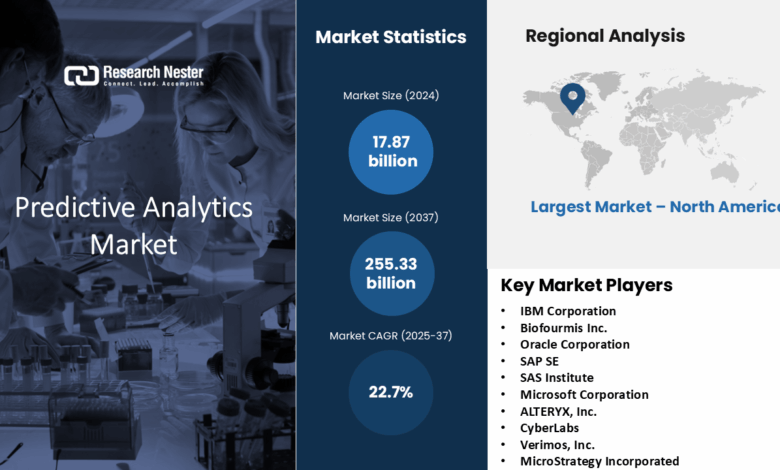
Entrepreneurship is encountering a huge shift as predictive analytics evolve from static reports and rearview analytics to neuro-symbolic AI and real-time predictive analytics. As the pace of business quickens, the ability to anticipate future market trends and consumer demand becomes essential. Yes! It is undeniable that the demand for the global predictive analytics industry is immense, and as per Research Nester’s data, the market will exceed the value of USD 255.33 billion by the end of 2037. As technologies such as AutoML, digital twins, and graph AI continue to evolve, organizations are transforming their approach to data management. They are moving from reliance on dashboard-driven insights to implementing self-optimizing workflows that can learn, adapt, and recommend actions in real time. In this scenario, an entrepreneur must stay well aware of the recent trends of predictive analytics, and this blog will do the same. So, explore the most recent trends of 2025 in predictive analytics and how they will impact the global business.
Recent Trends in Predictive Analytics to Look Out For in 2025
As businesses are becoming more tech-savvy than ever, the demand for predictive analytics empowered with AI and machine learning is increasing. Recently, Dell founder, Chairman, and CEO Michael Dell’s statement went viral. According to him, Dell is planning to move 85% of its business ground plan to generative AI workloads on-premises within 24 months from May 2025. Unimaginable, right? But this is the future of businesses worldwide. Predictive analytics and its recent advancements are the backbone behind a company’s success. Here, let’s go through the blog and unwrap what’s waiting for businesses in the tech world.
1. Real-time Predictive Analytics
Ever ordered food from Uber Eats? Yeah! we all are guilty of that! After ordering food from Uber Eats, a notification pops up showing the estimated time of delivery; that’s the work of predictive analytics. Real-time predictive analytics analyzes data and produces insights that prompt immediate decision-making in response to events as they happen.
Why Businesses Adopt It?
Here are some reasons why businesses can enjoy leveraging real-time predictive analytics.
- It promptly makes decisions by analyzing real-time data.
- Resulting in quicker and more flexible operations
- Customers stay happy due to a prompt response
- Reduced coordination malfunction, scams, and postponements
Real World Application: The latest version of Mastercard’s AI-driven fraud detection system utilizes advanced AI technology to analyze approximately 160 billion transactions annually. This tool can detect fraud by 300% and was incorporated in May 2025.
2. Neuro-symbolic AI
Sounds like a sci-fi Hollywood movie’s name. Isn’t it? Neuro-symbolic is an amalgamation of neural networks and symbolic reasoning. What it mainly does is it viaducts the gap between learning data and giving reasons to it.
Why Businesses Adopt It?
Here are a few amazing facts about adopting neuro-symbolic AI to businesses;
- It provides logical and intricate decisions
- It can perform complicated tasks taking little data
- Makes it easier to audit and explain the AI decision
- Have the power to tackle logical reasoning and edge cases better than pure deep learning.
Real World Application: CoCoSys created its first neuro-symbolic AI chip in May 2025, which amalgamates the learning skill of neural networks with the logical reasoning of symbolic AI to develop smarter, more humanized artificial intelligence.
3. Synthetic Data for Prediction Precision
How all the sensitive data of a person stays protected in a server? Here comes the role of synthetic data. Synthetic data was developed to address the deficiencies associated with real-world data, which may be limited, sensitive, or biased.
Why Businesses Adopt It?
Here are some reasons that businesses are incorporating synthetic data;
- Improves bias rectifications and fairness in AI
- Intensifies model precision by branching out the training data
- Protects privacy by not disclosing the real identities
- Offers prompter modeling and testing of anticipated models
Real World Application: Scientists have come up with RoentGen model. It is a text-to-image generative model that is used in the healthcare sector to make practical X-ray images based on medically appropriate text prompts. It has enhanced a 95% to 97% of classification performance showcasing the benefits of synthetic data.
4. Automated Machine Learning (Auto-ML) 2.0
AutoML 2.0 is similar to AUtoML but better. AutoML 2.0 supports in creating quicker prototype and smarter automation with less human interference. Perfect for businesses!
Why Businesses Adopt It?
Here’s why businesses inculcating auto-ML 2.0;
- Ramps up the prototyping quicker
- Even a novice can use AI because it reduces reliance on developers
- Improves model transparency and conformity
- Promotes ongoing learning and automated retraining
Real World Application: Companies adopting AutoML complete model development in 60% to 80% less time than conventional techniques. Wells Fargo employs AutoML platforms to enhance the capabilities of its risk and compliance teams.
Predictive Analytics: The Future of Businesses
To sum up, predictive analytics has completely transformed today. It has gone far beyond being just a mere supporting equipment, it is now a critical component for modern businesses. The above-mentioned trends would offer quicker decisions, enhanced precision, and provide in-depth strategies. The future is for the entrepreneurs who not only predict the future but always remain prepared for action.





